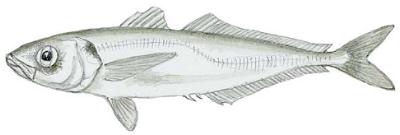Not a true mackerel but a member of the Carangidae family of jacks, the Pacific jack mackerel is marketed fresh, smoked, canned, and frozen.
Identification
The body of the Pacific jack mackerel is somewhat compressed and elongate, with a tail that is as broad as it is deep. It is metallic blue to olive green on the back, shading to silver on the belly. Its last dorsal and anal soft rays are attached to the body or rarely separated from the fins, and the sides are covered with enlarged scales. The Pacific jack mackerel bears a resemblance to the Mexican scad, but the enlarged scales distinguish it, as do the last, attached rays of the dorsal and the anal fins. On the Mexican scad, the rays are isolated finlets.
Size/Age
The Pacific jack mackerel can weigh 4 to 5 pounds and can live 20 to 30 years.
Spawning behavior
Sexual maturity comes early for Pacific jack mackerel. Half of the females are ready to spawn at age 2, and all fish spawn by age 3. Spawning takes place from March through June over a considerable area, from 80 to more than 240 miles offshore.
Food and feeding habits
Pacific jack mackerel feed on small crustaceans and fish larvae, as well as on anchovies, lanternfish, and juvenile squid.
Other Names
horse mackerel, jack mackerel, jackfish, mackereljack, scad; Spanish: charrito, chicharro.
Distribution
In the eastern Pacific, Pacific jack mackerel range from south-eastern Alaska to southern Baja California, extending into the Gulf of California, Mexico. They are also reported from Acapulco, Mexico, and the Galápagos Islands.
Habitat
Pacific jack mackerel are often found offshore in large schools; adults are found up to 500 miles from the coast and in depths of up to 150 feet. Young fish school near kelp and under piers, whereas larger fish often move off-shore or northward.


